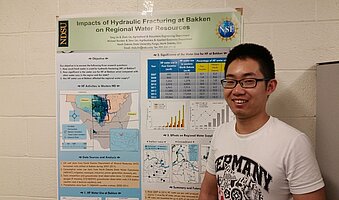Developing an Agent-Based Model for the Water Allocation System at Bakken for Regional Water Resource Management.

Tong Lin is an M.S. student in the Environmental Science and Conservation Program at North Dakota University (NDSU). He holds a B.S. degree in Geographic Information System from Anhui Normal University, China. Tong Lin is currently working on an NSF funded project titled “A Model for Groundwater Allocation and Management at the Bakken Shale in Western North Dakota”. His research is focused on assessing fresh water use for hydraulic fracturing at Bakken and their current and future impacts on regional water resources.
Email: tong.lin@ndsu.edu
Phone: (701)-730-8064
Fellow: Tong Lin
Advisor: Dr. Zhulu Lin, Department of Agricultural and Biosystems Engineering, NDSU
Degree Progress: M.S. in Environmental and Conservation Sciences Program, expected to graduate in December 2016
Developing an Agent-Based Model for the Water Allocation System at Bakken for Regional Water Resource Management.
The combined use of hydraulic fracturing and horizontal drilling techniques for oil and gas well development made it possible to economically extract oil and gas resources previously inaccessible. The resulting surge in production increased domestic energy supplies and brought economic benefits to many areas of the US. From 2008 to 2013, unconventional oil production from Bakken Shale of western North Dakota increased nearly ten-fold. Since 2012 North Dakota has become the nation’s second largest oil producing states behind only Texas. Although unconventional oil production uses less water than conventional oil production per unit of energy, the cumulative water needs for unconventional oil production due to multiple drilling and fracturing operations may be locally or temporally significant. Our data analysis shows that water used for hydraulic fracturing in western North Dakota increased more than 70 times from 302 ac-ft (0.37 million m3) in 2007 to 21,605 ac-ft (26.7 million m3) in 2014.
In western North Dakota, except for Missouri River and Lake Sakakawea, the storage of surface waters and shallow aquifers is limited and subject to drought condition. Much of the state’s surface waters and shallow aquifers are fully or nearly fully appropriated. To better manage the region’s surface water and groundwater resources, it is imperative to have a good understanding of the water demand from hydraulic fracturing and its current and future impacts on regional water resources.
Project Objectives:
Our proposed research is to estimate hydraulic fracturing water use at Bakken and to analyze its current and future impacts on regional water resources. Specific objectives include:
- Estimating hydraulic fracturing (HF) water use at Bakken and assessing its impacts on regional water resources.
- Developing an agent-based model to better understand the water depot based water allocation system in western North Dakota.
Progress:
We have obtained and analyzed the Bakken horizontal well data and North Dakota water withdrawal data. We have also retrieved the daily streamflow observations at 12 USGS stream gage stations and the groundwater level data observed at 210 NDSWC groundwater observation wells in western ND. Up to date, we had finished these data analysis. Now, we are in the process of developing an agent-based model for the water depots in western North Dakota and running scenario analysis for regional water management.
Significance:
Our research will help to quantify how much fresh water is used for hydraulic fracturing at Bakken, how significant HF water use at Bakken when compared with other types of water use, and how HF water use at Bakken has affected the surface water and groundwater resources in the region. Our research will also develop an agent-based model for the unique water depot based water allocation system. A clear understanding of the dynamics of the water depot based water allocation system and its interactions with individual streams and aquifers in the region will help policy and decision makers devise appropriate policy tools to manage the regional water resources for long-term and sustainable use.
Research Outcomes:
Lin, T. and Z. Lin (2015). How does oil and gas production in the Bakken impact water use in North Dakota? The American Society of Agricultural and Biological Engineers (ASABE) North Central Intersectional Conference, 10 - 11 April, 2015, Fargo, North Dakota, USA.
Lin, Z., T. Lin, and S.H. Lim (2015). Groundwater allocation and management at Bakken in western North Dakota. Proceedings of MODFLOW and More 2015: Modeling a Complex World, R. Maxwell, M. Hill, C. Zheng, and M. Tonkin (eds.), Integrated Groundwater Modeling Center, Golden, CO.
Lin, T. and Z. Lin (2015). Developing an agent-based model for the depot-based water allocation system in the Bakken field in western North Dakota. 2015 American Geophysical Union (AGU) Fall Meeting, 14 - 18 December, 2015, San Francisco, California, USA (poster).
Lin, T. and Z. Lin (2016). The Impacts of Hydraulic Fracturing at Bakken on Regional Water Resources. 2016 North Dakota Experimental Program to Stimulate Competitive Research (ND EPSCoR) State Conference, 14 April, 2016, Grand Forks, North Dakota, USA (poster).

Zhulu Lin
AES Ag & Biosystems Eng
Office: Ag & Bio Eng 104
Telephone: 701-231-7118
Email: zhulu.lin@ndsu.edu


